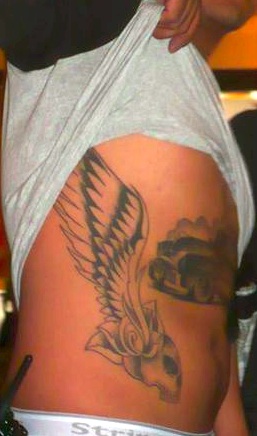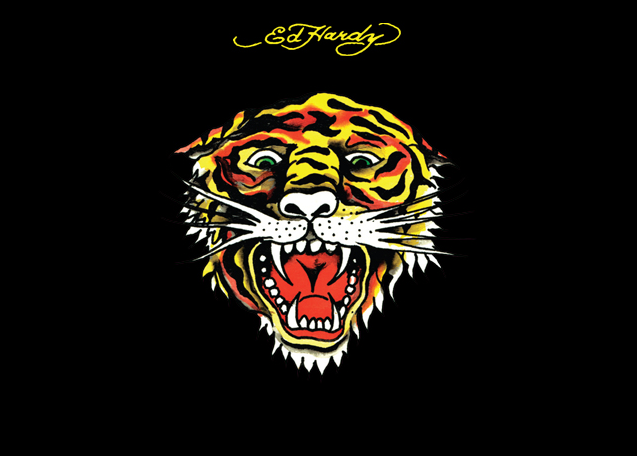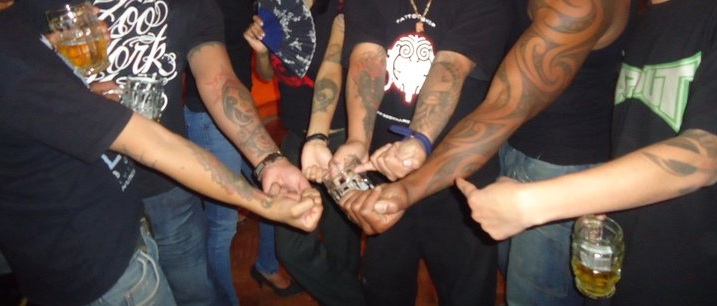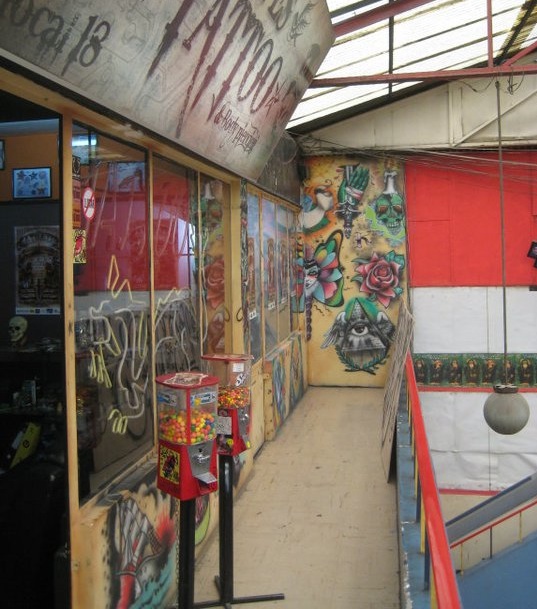Gonz wears a black Pantera shirt over a black turtleneck. He has long, thick wavy hair pulled back in a ponytail. He has two lip piercings (of the sort I’ve heard my sister call “snakebites”), along with a few silver hoops in his ears.
Alé often wears an Ed Hardy shirt with a tiger on it that he told me he bought at the El Alto market one Sunday. He wears baggy light colored jeans and black Adidas shoes that often have the laces untied. His dark brown leather jacket has a sweatshirt hood poking out the collar. He shaves his head to the second lowest setting once a week. He has small black flesh plug earrings, and his right hand has a tattoo in black and red of a rotary tattoo machine that says “calibración.”
Edwin, the owner, in many ways looks the least menacing of them all. His medium sized flesh tunnel earrings are the most obvious visible nod to his career. He wears glasses that hover in the space between hipster and dorky. The night that Gonz surprised me with his energy, Edwin wore a white tshirt with the DC skateboarding logo on it. After 2 beers, he lifted it up to reveal the tattoo of a classic 1950s auto. He said, “and it’s a transformer!” I was puzzled. Then I started laughing hysterically as he puffed out the stomach and it resembled more of a VW bug than a long lean car.
Diego, I always picture in his “Johnny Walked” shirt—with the Johnny Walker logo, only in a wheelchair. He has black spiky hair and fairly large flesh tunnel earrings. He almost always wears ray ban sunglasses outdoors. He has a goatee and tattoos peak out of his shirt on his neck and his arms.
What they have accumulated, among other things, is the ability to perform as authentic tattoo artists. Much has been written on the ways that both dress (Adkins and Lury 1999, Atluri 2009, Halberstam 1998), and purchase of goods (Mort 1995, 1998, Tomlinson 1990) work to perform authenticity of identity. Because they rely on social scripts (the ones that tell us not to trust a barber with a bad haircut or a tattoo artist with no tattoos), over time these symbols congeal to produce appearance of naturalness (Butler 1999:44). (Well, of course my tattoo artist wears a leather jacket. What would you expect? A tweed sport coat?)
As Bucholtz and Hall explain, authenticity (or as they say, “authentication,” to emphasize its active and processual nature) is about realness in contrast to artifice. Certain accumulations (clothing, tattoos and piercings for the Tito’s guys, or boyfriends from Travestis in India) provide validation for identities (2005:500).
Often authentication of identity is achieved through connection to valued symbols (Bucholtz and Hall 2005:500). But as Lowe writes, “All body practices [production practices, consumption practices, social reproduction practices, practices of sexuality and gender construction, and practices of psychopathology] have become commodified to such an extent, that the satisfaction of our diverse bodily needs is reconfigured by the requirements of flexible accumulation" (1995). Thus the “valued symbols” of today are often connected to certain brand names: Ed Hardy, DC, Pantera (yes I, along with other more respectable figures, argue bands at times may constitute a brand in and of itself).
Much like the travelers at the Ekko bar, the tattooists flexibly accumulate symbols of their identities: t shirts that reference “alternative” subcultures related to music or skateboarding, piercings of various sizes, visible tattoos, and bodily comportment that indexes an atagonistic attitude toward the world (authority?). And like the tourists, this accumulation, though it relies on certain forms of consumption, is not simply about buying specific products, but includes the accumulation of non-commodified symbols. Alé’s image of the tattoo machine on his hand is a clear example. Even his Ed Hardy tshirt, which likely cost less than 5Bs (75 cents) in El Alto is a product that is purchased, but is important for its social capital rather than its economic worth.
However, as Carolan (2005) argues, in this new era of conspicuous consumption, surrounding oneself with "nice things" is insufficient … rather we are striving to become the 'Nice thing" itself, to literally embody our consumption. He suggests this is visible in the ways bodies are dressed, fed, comported, and even their apparent "health.” The outward appearance of one's body is considered to be a window to one's inner worthiness. Thus we arrive back at the body, a vehicle for brands and symbols. Litterally punctured. Literally written upon. And yet, perhaps it is the (somewhat) irreversible nature of these two latter processes that provides the sense of authenticity. A gate can be altered. A shirt can be changed. I know that Alé has a suit hanging in his closet. But that “calibración” on his hand is still going to be visible. And is still going to reference a very specific identity.
1999 The Labour of Identity: Performing Identities, Performing Economies. Economy and Society 28(4):598-614.
Atluri, Tara
2009 Lighten Up?! Humour, Race, and Da Off Colour Joke of Ali G. Media, Culture, & Society 31(2):197-214
Bucholtz, Mary and Kira Hall
2005 Identity and Interaction: A Sociocultural Linguistic Approach. Discourse Studies 7(4-5):585-614.
Butler, Judith
1999 Gender Trouble. New York: Routledge.
Carolan, Michael S.
2005 The Conspicuous Body: Capitalism, Consumerism, Class and Consumption. Worldviews 9(1):82-111.
Halberstam, Judith
1998 Female Masculinity. Durham: Duke University Press.
Lowe, Donald M.
1995 The Body in Late-Capitalist USA. Durham: Duke University Press.
Mort, Frank
1998 Cityscapes: Consumption, Masculinities and the Mapping of London since 1950. Urban Studies 35(5-6):889-907.
1995 Archaeologies of City Life: Commerical Culture, Masculinity, and Spatial Relations in 1980s London. Environment and Planning D: Society and Space 13:573-590.
Tomlinson, Alan
1990 Consumption, Identity, and Style: Marketing, Meanings, and the Packaging of Pleasure. New York: Routledge.




 RSS Feed
RSS Feed
